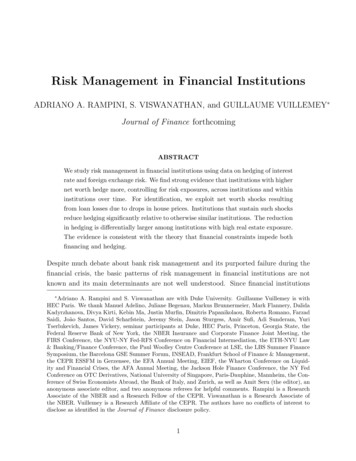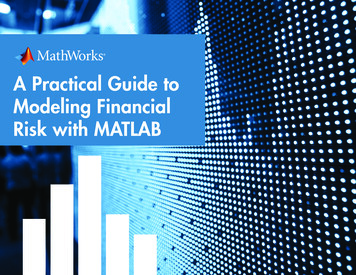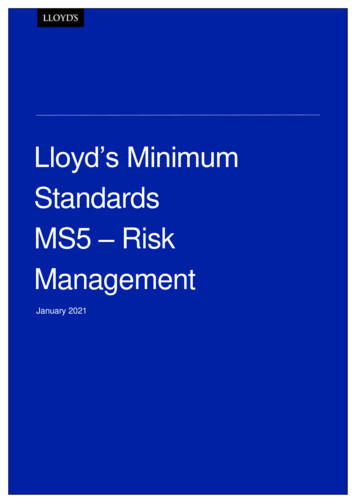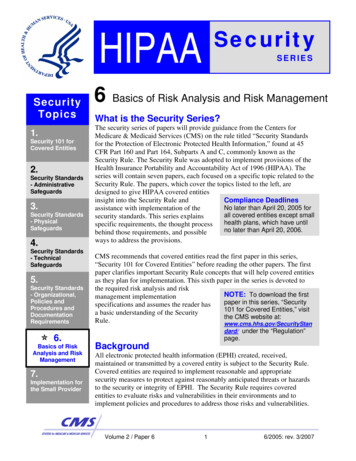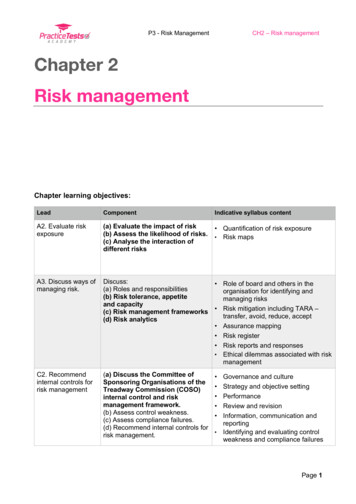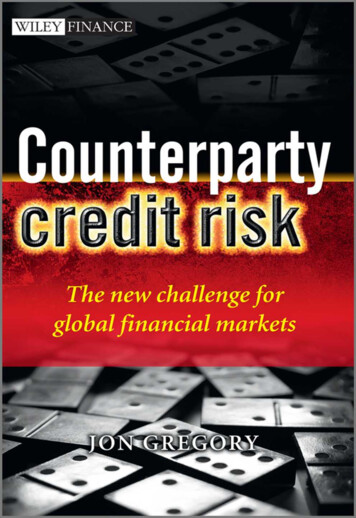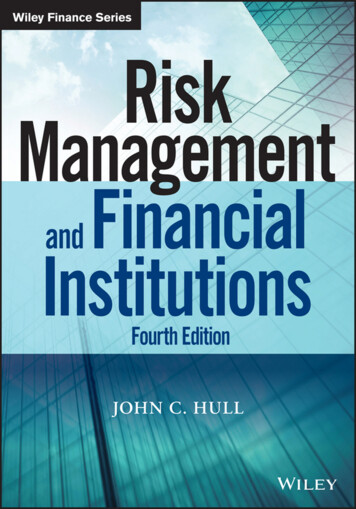
Transcription
Risk Managementand FinancialInstitutions
Founded in 1807, John Wiley & Sons is the oldest independent publishing company in the United States. With offices in North America, Europe, Australia andAsia, Wiley is globally committed to developing and marketing print and electronicproducts and services for our customers’ professional and personal knowledge andunderstanding.The Wiley Finance series contains books written specifically for finance and investment professionals as well as sophisticated individual investors and their financialadvisors. Book topics range from portfolio management to e-commerce, risk management, financial engineering, valuation and financial instrument analysis, as wellas much more.For a list of available titles, visit our Web site at www.WileyFinance.com.
Risk Managementand FinancialInstitutionsFourth EditionJOHN C. HULL
Cover image: iStock.com/PinkypillsCover design: WileyCopyright 2015 by John C. Hull. All rights reserved.Published by John Wiley & Sons, Inc., Hoboken, New Jersey.The Third Edition was published by John Wiley & Sons, Inc. in 2012. The first and second editions ofthis book was published by Prentice Hall in 2006 and 2009.Published simultaneously in Canada.No part of this publication may be reproduced, stored in a retrieval system, or transmitted in any form orby any means, electronic, mechanical, photocopying, recording, scanning, or otherwise, except aspermitted under Section 107 or 108 of the 1976 United States Copyright Act, without either the priorwritten permission of the Publisher, or authorization through payment of the appropriate per-copy fee tothe Copyright Clearance Center, Inc., 222 Rosewood Drive, Danvers, MA 01923, (978) 750-8400,fax (978) 646-8600, or on the Web at www.copyright.com. Requests to the Publisher for permissionshould be addressed to the Permissions Department, John Wiley & Sons, Inc., 111 River Street, Hoboken,NJ 07030, (201) 748-6011, fax (201) 748-6008, or online at http://www.wiley.com/go/permissions.Limit of Liability/Disclaimer of Warranty: While the publisher and author have used their best efforts inpreparing this book, they make no representations or warranties with respect to the accuracy orcompleteness of the contents of this book and specifically disclaim any implied warranties ofmerchantability or fitness for a particular purpose. No warranty may be created or extended by salesrepresentatives or written sales materials. The advice and strategies contained herein may not be suitablefor your situation. You should consult with a professional where appropriate. Neither the publisher norauthor shall be liable for any loss of profit or any other commercial damages, including but not limited tospecial, incidental, consequential, or other damages.For general information on our other products and services or for technical support, please contact ourCustomer Care Department within the United States at (800) 762-2974, outside the United States at(317) 572-3993 or fax (317) 572-4002.Wiley publishes in a variety of print and electronic formats and by print-on-demand. Some materialincluded with standard print versions of this book may not be included in e-books or in print-on-demand.If this book refers to media such as a CD or DVD that is not included in the version you purchased, youmay download this material at http://booksupport.wiley.com. For more information about Wileyproducts, visit www.wiley.com.Library of Congress Cataloging-in-Publication Data:Hull, John, 1946–Risk management and financial institutions / John C. Hull. — Fourth Edition.pages cm. — (Wiley finance series)Includes index.ISBN 978-1-118-95594-9 (paper); ISBN 978-1-118-95596-3 (ePDF);ISBN 978-1-118-95595-6 (ePUB)1. Risk management. 2. Financial institutions—Management. I. Title.HD61.H83 2015332.1068'1—dc232014037477Printed in the United States of America10987654321
To Michelle, Peter, and David
Contents in BriefBusiness SnapshotsPrefaceChapter 1: Introductionxxixxiii1PART ONE : FINANCIAL INSTITUTIONS AND THEIR TRADINGChapter 2: BanksChapter 3: Insurance Companies and Pension PlansChapter 4: Mutual Funds and Hedge FundsChapter 5: Trading in Financial MarketsChapter 6: The Credit Crisis of 2007Chapter 7: Valuation and Scenario Analysis: The Risk-Neutral and Real Worlds25457193121137PART TWO : MARKET RISKChapter 8: How Traders Manage Their RisksChapter 9: Interest Rate RiskChapter 10: VolatilityChapter 11: Correlations and CopulasChapter 12: Value at Risk and Expected ShortfallChapter 13: Historical Simulation and Extreme Value TheoryChapter 14: Model-Building Approach153175201231255277299PART THREE : REGULATIONChapter 15: Basel I, Basel II, and Solvency IIChapter 16: Basel II.5, Basel III, and Other Post-Crisis ChangesChapter 17: Fundamental Review of the Trading Book325353373PART FOUR : CREDIT RISKChapter 18: Managing Credit Risk: Margin, OTC Markets, and CCPsChapter 19: Estimating Default ProbabilitiesChapter 20: CVA and DVAChapter 21: Credit Value at Risk383401429447PART FIVE : OTHER TOPICSChapter 22: Scenario Analysis and Stress TestingChapter 23: Operational RiskChapter 24: Liquidity RiskChapter 25: Model RiskChapter 26: Economic Capital and RAROCChapter 27: Enterprise Risk ManagementChapter 28: Risk Management Mistakes to Avoid463481501527547565579PART SIX : APPENDICESAppendicesAnswers to Questions and ProblemsGlossaryDerivaGem SoftwareTables for N(x)Index591629669689695699vii
ContentsBusiness SnapshotsPrefacexxiiiCHAPTER 1Introduction1.11.21.31.41.51.61.7xxiRisk vs. Return for InvestorsThe Efficient FrontierThe Capital Asset Pricing ModelArbitrage Pricing TheoryRisk vs. Return for CompaniesRisk Management by Financial InstitutionsCredit RatingsSummaryFurther ReadingPractice Questions and Problems (Answers at End of Book)Further Questions12581313171819191920PART ONEFINANCIAL INSTITUTIONS AND THEIR TRADINGCHAPTER 2Banks2.12.22.32.42.52.62.72.8Commercial BankingThe Capital Requirements of a Small Commercial BankDeposit InsuranceInvestment BankingSecurities TradingPotential Conflicts of Interest in BankingToday’s Large BanksThe Risks Facing BanksSummaryFurther ReadingPractice Questions and Problems (Answers at End of Book)Further Questions25262830313637384142434344ix
xCONTENTSCHAPTER 3Insurance Companies and Pension Plans3.13.23.33.43.53.63.73.83.93.103.113.12Life InsuranceAnnuity ContractsMortality TablesLongevity and Mortality RiskProperty-Casualty InsuranceHealth InsuranceMoral Hazard and Adverse SelectionReinsuranceCapital RequirementsThe Risks Facing Insurance CompaniesRegulationPension PlansSummaryFurther ReadingPractice Questions and Problems (Answers at End of Book)Further QuestionsCHAPTER 4Mutual Funds and Hedge Funds4.14.24.34.4Mutual FundsHedge FundsHedge Fund StrategiesHedge Fund PerformanceSummaryFurther ReadingPractice Questions and Problems (Answers at End of Book)Further QuestionsCHAPTER 5Trading in Financial Markets5.15.25.35.45.55.65.75.85.9The MarketsClearing HousesOTC Market ChangesLong and Short Positions in AssetsDerivatives MarketsPlain Vanilla DerivativesNon-Traditional DerivativesExotic Options and Structured ProductsRisk Management ChallengesSummaryFurther ReadingPractice Questions and Problems (Answers at End of Book)Further 4888990909193939495969798108112114116116117119
xiContentsCHAPTER 6The Credit Crisis of 20076.16.26.36.46.5The U.S. Housing MarketSecuritizationThe CrisisWhat Went Wrong?Lessons from the CrisisSummaryFurther ReadingPractice Questions and Problems (Answers at End of Book)Further QuestionsCHAPTER 7Valuation and Scenario Analysis: The Risk-Neutral and Real Worlds7.17.27.37.47.57.6Volatility and Asset PricesRisk-Neutral ValuationScenario AnalysisWhen Both Worlds Have to be UsedThe Calculations in PracticeEstimating Real-World ProcessesSummaryFurther ReadingPractice Questions and Problems (Answers at End of Book)Further 4144145146147148148148PART TWOMARKET RISKCHAPTER 8How Traders Manage Their lating Greek Letters8.7Taylor Series Expansions8.8The Realities of Hedging8.9Hedging Exotic Options8.10 Scenario AnalysisSummaryFurther ReadingPractice Questions and Problems (Answers at End of Book)Further 2173
xiiCONTENTSCHAPTER 9Interest Rate 91193196197197198199Definition of VolatilityImplied VolatilitiesAre Daily Percentage Changes in Financial Variables Normal?The Power LawMonitoring Daily VolatilityThe Exponentially Weighted Moving Average ModelThe GARCH(1,1) ModelChoosing Between the ModelsMaximum Likelihood MethodsUsing GARCH(1,1) to Forecast Future VolatilitySummaryFurther ReadingPractice Questions and Problems (Answers at End of Book)Further 8CHAPTER .10201CHAPTER 11Correlations and Copulas11.111.211.311.411.5175The Management of Net Interest IncomeTypes of RatesDurationConvexityGeneralizationNonparallel Yield Curve ShiftsInterest Rate Deltas in PracticePrincipal Components AnalysisGamma and VegaSummaryFurther ReadingPractice Questions and Problems (Answers at End of Book)Further QuestionsDefinition of CorrelationMonitoring CorrelationMultivariate Normal DistributionsCopulasApplication to Loan Portfolios: Vasicek’s ModelSummaryFurther ReadingPractice Questions and Problems (Answers at End of Book)Further Questions231231233236238244250250250252
xiiiContentsCHAPTER 12Value at Risk and Expected Definition of VaRExamples of the Calculation of VaRA Drawback of VaRExpected ShortfallCoherent Risk MeasuresChoice of Parameters for VaR and ESMarginal, Incremental, and Component MeasuresEuler’s TheoremAggregating VaRs and ESsBack-TestingSummaryFurther ReadingPractice Questions and Problems (Answers at End of Book)Further QuestionsCHAPTER 13Historical Simulation and Extreme Value Theory13.113.213.313.413.513.6The MethodologyAccuracy of VaRExtensionsComputational IssuesExtreme Value TheoryApplications of EVTSummaryFurther ReadingPractice Questions and Problems (Answers at End of Book)Further QuestionsCHAPTER 14Model-Building he Basic MethodologyGeneralizationCorrelation and Covariance MatricesHandling Interest RatesApplications of the Linear ModelLinear Model and OptionsQuadratic ModelMonte Carlo SimulationNon-Normal AssumptionsModel-Building vs. Historical SimulationSummaryFurther ReadingPractice Questions and Problems (Answers at End of Book)Further 07310311314316317318319319319321
xivCONTENTSPART THREEREGULATIONCHAPTER 15Basel I, Basel II, and Solvency II15.1The Reasons for Regulating Banks15.2Bank Regulation Pre-198815.3The 1988 BIS Accord15.4The G-30 Policy Recommendations15.5Netting15.61996 Amendment15.7Basel II15.8Credit Risk Capital Under Basel II15.9Operational Risk Capital Under Basel II15.10 Pillar 2: Supervisory Review15.11 Pillar 3: Market Discipline15.12 Solvency IISummaryFurther ReadingPractice Questions and Problems (Answers at End of Book)Further QuestionsCHAPTER 16Basel II.5, Basel III, and Other Post-Crisis Changes16.116.216.316.416.5Basel II.5Basel IIIContingent Convertible BondsDodd–Frank ActLegislation in other CountriesSummaryFurther ReadingPractice Questions and Problems (Answers at End of Book)Further QuestionsCHAPTER 17Fundamental Review of the Trading Book17.117.217.3New Market Risk MeasuresTrading Book vs. Banking BookCredit TradesSummaryFurther ReadingPractice Questions and Problems (Answers at End of Book)Further 78379379379380
xvContentsPART FOURCREDIT RISKCHAPTER 18Managing Credit Risk: Margin, OTC Markets, and CCPs18.118.218.318.4Margin and ExchangesOTC MarketsConsequences of New OTC RegulationsThe Risk of a CCP FailureSummaryFurther ReadingPractice Questions and Problems (Answers at End of Book)Further QuestionsCHAPTER 19Estimating Default t RatingsHistorical Default ProbabilitiesRecovery RatesCredit Default SwapsCredit SpreadsEstimating Default Probabilities from Credit SpreadsComparison of Default Probability EstimatesUsing Equity Prices to Estimate Default ProbabilitiesSummaryFurther ReadingPractice Questions and Problems (Answers at End of Book)Further QuestionsCHAPTER 20CVA and DVA20.120.220.320.420.520.620.7Credit Exposure on DerivativesCVAThe Impact of a New TransactionCVA RiskWrong-Way RiskDVASome Simple ExamplesSummaryFurther ReadingPractice Questions and Problems (Answers at End of Book)Further 41442442443
xviCONTENTSCHAPTER 21Credit Value at Risk21.121.221.321.421.5Ratings Transition MatricesVasicek’s ModelCredit Risk PlusCreditmetricsCredit-Sensitive Instruments in the Trading BookSummaryFurther ReadingPractice Questions and Problems (Answers at End of Book)Further Questions445446448449451454457458458459PART FIVEOTHER TOPICSCHAPTER 22Scenario Analysis and Stress Testing22.122.222.3Generating the ScenariosRegulationWhat to Do with the ResultsSummaryFurther ReadingPractice Questions and Problems (Answers at End of Book)Further QuestionsCHAPTER 23Operational Risk23.1Defining Operational Risk23.2Determination of Regulatory Capital23.3Categorization of Operational Risks23.4Loss Severity and Loss Frequency23.5Implementation of AMA23.6Proactive Approaches23.7Allocation of Operational Risk Capital23.8Use of Power Law23.9Insurance23.10 Sarbanes-OxleySummaryFurther ReadingPractice Questions and Problems (Answers at End of Book)Further QuestionsCHAPTER 24Liquidity Risk24.124.2Liquidity Trading RiskLiquidity Funding 92492493494495496496497499499507
xviiContents24.3Liquidity Black HolesSummaryFurther ReadingPractice Questions and Problems (Answers at End of Book)Further QuestionsCHAPTER 25Model Risk25.125.225.325.425.525.625.725.8Marking to MarketModels for Linear ProductsPhysics vs. FinanceHow Models are Used for Pricing Standard ProductsHedgingModels for Nonstandard ProductsDangers in Model BuildingDetecting Model ProblemsSummaryFurther ReadingPractice Questions and Problems (Answers at End of Book)Further QuestionsCHAPTER 26Economic Capital and RAROC26.126.226.326.426.526.626.726.8Definition of Economic CapitalComponents of Economic CapitalShapes of the Loss DistributionsRelative Importance of RisksAggregating Economic CapitalAllocation of Economic CapitalDeutsche Bank’s Economic CapitalRAROCSummaryFurther ReadingPractice Questions and Problems (Answers at End of Book)Further QuestionsCHAPTER 27Enterprise Risk Management27.127.227.327.4Risk AppetiteRisk CultureIdentifying Major RisksStrategic Risk ManagementSummaryFurther ReadingPractice Questions and Problems (Answers at End of Book)Further 60563564568572574575576576576
xviiiCONTENTSCHAPTER 28Risk Management Mistakes to Avoid28.128.228.328.428.5Risk LimitsManaging the Trading RoomLiquidity RiskLessons for Nonfinancial CorporationsA Final PointFurther Reading577577580582585586587PART SIXAPPENDICESAppendix ACompounding Frequencies for Interest Rates591Appendix BZero Rates, Forward Rates, and Zero-Coupon Yield Curves595Appendix CValuing Forward and Futures Contracts599Appendix DValuing Swaps601Appendix EValuing European Options603Appendix FValuing American Options605Appendix GTaylor Series Expansions609Appendix HEigenvectors and Eigenvalues613Appendix IPrincipal Components Analysis617Appendix JManipulation of Credit Transition Matrices619Appendix KValuation of Credit Default Swaps621
ContentsxixAppendix LSynthetic CDOs and Their Valuation625Answers to Questions and Problems629Glossary669DerivaGem Software689Table for N(x) when x 0695Table for N(x) when x 0697Index699
Business 22.223.123.224.124.224.324.425.125.225.3The Hidden Costs of BankruptcyGoogle’s IPOPeopleSoft’s Poison PillHow to Keep Loans PerformingEquitable LifeA Perfect StormMutual Fund Returns Can Be MisleadingThe Unanticipated Delivery of a Futures ContractA Software Error?Microsoft’s HedgingProcter and Gamble’s Bizarre DealSocGen’s Big Loss in 2008All BBBs Are Not the SameA Trading Opportunity?Hedging by Gold Mining CompaniesDynamic Hedging in PracticeIs Delta Hedging Easier or More Difficult for Exotics?What Causes Volatility?Making Money from Foreign Currency OptionsHistorical Perspectives on VaRSystemic RiskCredit Suisse’s CoCo Bond IssuesRehypothecationThe CDS MarketIs the CDS Market a Fair Game?ContagionLong-Term Capital Management’s Big LossTraffic Light OptionsThe Hammersmith and Fulham StoryRogue Trader InsuranceNorthern RockAshanti GoldfieldsMetallgesellschaftThe Crash of 1987Kidder Peabody’s Embarrassing MistakeExploiting the Weaknesses of a Competitor’s 508511512518528529533xxi
xxii25.426.127.127.228.1BUSINESS SNAPSHOTSThe London WhaleThe EGT FundThe Santander Rail DealAbacusBig Losses539551570571578
Prefaceisk management practices and the regulation of financial institutions have continued to evolve in the past three years. Risk Management and Financial Institutionshas been expanded and updated to reflect this. Like my other popular text Options,Futures, and Other Derivatives, the book is designed to be useful to practicing managers as well as college students. Those studying for GARP and PRMIA qualificationswill find the book particularly helpful.The book is appropriate for university courses in either risk management orfinancial institutions. It is not necessary for students to take a course on options andfutures markets prior to taking a course based on this book. But if they have takensuch a course, some of the material in the first nine chapters does not need to becovered.The level of mathematical sophistication and the way material is presented havebeen managed carefully so that the book is accessible to as wide an audience as possible. For example, when covering copulas in Chapter 11, I present the intuition followed by a detailed numerical example; when covering maximum likelihood methodsin Chapter 10 and extreme value theory in Chapter 13, I provide numerical examplesand enough details for readers to develop their own Excel spreadsheets. I have alsoprovided my own Excel spreadsheets for many applications on my website:Rwww-2.rotman.utoronto.ca/ hullThis is a book about risk management, so there is very little material on thevaluation of derivatives. (This is the main focus of my other two books, Options,Futures, and Other Derivatives and Fundamentals of Futures and Options Markets.)The appendices at the end of the book include material that summarizes some ofthe valuation key results that are important in risk management, and the DerivaGemsoftware can be downloaded from my website.NEW MATERIALThe fourth edition has been fully updated and contains much new material. Inparticular:1. There is a new chapter comparing scenario analysis to valuation (Chapter 7).The chapter introduces the reader to the statistical processes often assumed forxxiii
xxiv2.3.4.5.6.7.8.9.10.PREFACEmarket variables (without any stochastic calculus), explains Monte Carlo simulation, and distinguishes between the real and risk-neutral worlds.There is a new chapter on the Fundamental Review of the Trading Book (Chapter17). This is an important new proposal from the Basel Committee.There is a new chapter on margin, OTC markets, and central counterparties(CCPs) (Chapter 18). This covers recent developments in the trading of over-thecounter derivatives and introduces the reader to a number of credit risk issues.There is a new chapter on enterprise risk management (Chapter 27). This discusses risk appetite, risk culture, and the importance of taking a holistic approachto risk management.The sequencing of the material in the book has been improved. For example, thecalculation of value at risk and expected shortfall is now covered immediatelyafter these risk measures are introduced. The book is now divided into six parts:financial institutions and their trading, market risk, regulation, credit risk, othertopics, and appendices.There is more emphasis throughout the book on the use of expected shortfall.This is consistent with the Basel Committee’s plans for changing the way marketrisk capital is calculated (see Chapter 17).The material on credit value adjustment (CVA) and debit value adjustment (DVA)has been restructured and improved (see Chapter 20).A new simpler method for taking volatility changes into account in the historicalsimulation method is presented (Chapter 13).There are many new end-of-chapter problems.A great deal of software on the author’s website accompanies the book.SLIDESSeveral hundred PowerPoint slides can be downloaded from my website or fromthe Wiley Higher Education website. Adopting instructors are welcome to adapt theslides to meet their own needs.QUESTIONS AND PROBLEMSEnd-of-chapter problems are divided into two groups: “Practice Questions and Problems” and “Further Questions.” Solutions to the former are at the end of the book.Solutions to the latter and accompanying software are available to adopting instructors from the Wiley Higher Education website.INSTRUCTOR’S MANUALThe instructor’s manual is made available to adopting instructors on the WileyHigher Education website. It contains solutions to “Further Questions” (with Excel spreadsheets), notes on the teaching of each chapter, and some suggestions oncourse organization.
xxvPrefaceACKNOWLEDGMENTSMany people have played a part in the production of this book. I have benefitedfrom interactions with many academics and practicing risk managers. I would liketo thank the students in my MBA and Master of Finance risk management courses atUniversity of Toronto, many of whom have made suggestions as to how the materialcould be improved.Alan White, a colleague at the University of Toronto, deserves a special acknowledgment. Alan and I have been carrying out joint research and consulting in the areaof derivatives and risk management for about 30 years. During that time we havespent countless hours discussing key issues. Many of the new ideas in this book, andmany of the new ways used to explain old ideas, are as much Alan’s as mine. Alanhas done most of the development work on the DerivaGem software.Special thanks are due to many people at Wiley, particularly Evan Burton,Vincent Nordhaus, Judy Howarth, and Helen Cho for their enthusiasm, advice, andencouragement.I welcome comments on the book from readers. My e-mail address is:hull@rotman.utoronto.caJohn HullJoseph L. Rotman School of ManagementUniversity of Toronto
CHAPTER1Introductionmagine you are the Chief Risk Officer (CRO) of a major corporation. The ChiefExecutive Officer (CEO) wants your views on a major new venture. You have beeninundated with reports showing that the new venture has a positive net present valueand will enhance shareholder value. What sort of analysis and ideas is the CEOlooking for from you?As CRO it is your job to consider how the new venture fits into the company’sportfolio. What is the correlation of the performance of the new venture with the restof the company’s business? When the rest of the business is experiencing difficulties,will the new venture also provide poor returns, or will it have the effect of dampeningthe ups and downs in the rest of the business?Companies must take risks if they are to survive and prosper. The risk management function’s primary responsibility is to understand the portfolio of risks that thecompany is currently taking and the risks it plans to take in the future. It must decidewhether the risks are acceptable and, if they are not acceptable, what action shouldbe taken.Most of this book is concerned with the ways risks are managed by banks andother financial institutions, but many of the ideas and approaches we will discussare equally applicable to nonfinancial corporations. Risk management has becomeprogressively more important for all corporations in the last few decades. Financialinstitutions in particular are finding they have to increase the resources they devoteto risk management. Large “rogue trader” losses such as those at Barings Bank in1995, Allied Irish Bank in 2002, Société Générale in 2007, and UBS in 2011 wouldhave been avoided if procedures used by the banks for collecting data on tradingpositions had been more carefully developed. Huge subprime losses at banks such asCitigroup, UBS, and Merrill Lynch would have been less severe if risk managementgroups had been able to convince senior management that unacceptable risks werebeing taken.This opening chapter sets the scene. It starts by reviewing the classical arguments concerning the risk-return trade-offs faced by an investor who is choosing aportfolio of stocks and bonds. It then considers whether the same arguments canbe used by a company in choosing new projects and managing its risk exposure.The chapter concludes that there are reasons why companies—particularly financialinstitutions—should be concerned with the total risk they face, not just with the riskfrom the viewpoint of a well-diversified shareholder.I1
2INTRODUCTIONTABLE 1.1Return in One Year from Investing 100,000 in a StockProbabilityReturn0.050.250.400.250.05 50% 30% 10% 10% 30%1.1 RISK VS. RETURN FOR INVESTORSAs all fund managers know, there is a trade-off between risk and return when moneyis invested. The greater the risks taken, the higher the return that can be realized.The trade-off is actually between risk and expected return, not between risk andactual return. The term “expected return” sometimes causes confusion. In everydaylanguage an outcome that is “expected” is considered highly likely to occur. However,statisticians define the expected value of a variable as its average (or mean) value.Expected return is therefore a weighted average of the possible returns, where theweight applied to a particular return equals the probability of that return occurring.The possible returns and their probabilities can be either estimated from historicaldata or assessed subjectively.Suppose, for example, that you have 100,000 to invest for one year. Supposefurther that Treasury bills yield 5%.1 One alternative is to buy Treasury bills. Thereis then no risk and the expected return is 5%. Another alternative is to invest the 100,000 in a stock. To simplify things, we suppose that the possible outcomes fromthis investment are as shown in Table 1.1. There is a 0.05 probability that the returnwill be 50%; there is a 0.25 probability that the return will be 30%; and so on.Expressing the returns in decimal form, the expected return per year is:0.05 0.50 0.25 0.30 0.40 0.10 0.25 ( 0.10) 0.05 ( 0.30) 0.10This shows that in return for taking some risk you are able to increase your expectedreturn per annum from the 5% offered by Treasury bills to 10%. If things work outwell, your return per annum could be as high as 50%. But the worst-case outcomeis a 30% return or a loss of 30,000.One of the first attempts to understand the trade-off between risk and expected return was by Markowitz (1952). Later, Sharpe (1964) and others carried theMarkowitz analysis a stage further by developing what is known as the capital assetpricing model. This is a relationship between expected return and what is termed“systematic risk.” In 1976, Ross developed the arbitrage pricing theory which canbe viewed as an extension of the capital asset pricing model to the situation where1This is close to the historical average, but quite a bit higher than the Treasury yields seen inthe years following 2008 in many countries.
3Introductionthere are several sources of systematic risk. The key insights of these researchers havehad a profound effect on the way portfolio managers think about and analyze therisk-return trade-offs that they face. In this section we review these insights.Quantifying RiskHow do you quantify the risk you are taking when you choose an investment? Aconvenient measure that is often used is the standard deviation of the return overone year. This is E(R2 ) [E(R)]2where R is the return per annum. The symbol E denotes expected value so that E(R)is the expected return per annum. In Table 1.1, as we have shown, E(R) 0.10. Tocalculate E(R2 ) we must weight the alternative squared returns by their probabilities:E(R2 ) 0.05 0.502 0.25 0.302 0.40 0.102 0.25 ( 0.10)2 0.05 ( 0.30)2 0.046The standard deviation of the annual return is therefore18.97%. 0.046 0.12 0.1897 orInvestment OpportunitiesSuppose we choose to characterize every investment opportunity by its expected return and standard deviation of return. We can plot available risky investments on achart such as Figure 1.1 where the horizontal axis is the standard deviation of thereturn and the vertical axis is the expected return.Once we have identified the expected return and the standard deviation of thereturn for individual investments, it is natural to think about what happens when wecombine investments to form a portfolio. Consider two investments with returns R1and R2 . The return from putting a proportion w1 of our money in the first investmentand a proportion w2 1 w1 in the second investment isw 1 R1 w 2 R2The portfolio expected return isμP w1 μ1 w2 μ2(1.1)where μ1 is the
Fundamental Review of the Trading Book 373 17.1 NewMarketRiskMeasures 373 17.2 TradingBookvs.BankingBook 377 17.3 CreditTrades 378 Summary 379 FurtherReading 379 PracticeQuestionsandProblems(AnswersatEndofBook) 379 FurtherQuestions 380
